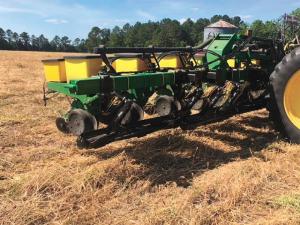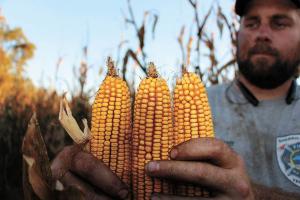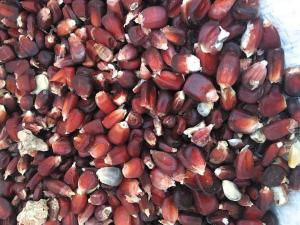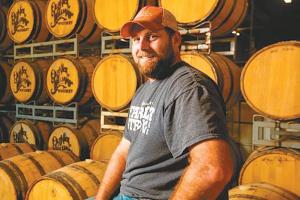New Farmer Succeeded By Looking For Advice, Found New Markets
Russell Hedrick breaks lots of rules with his open-pollinated heritage corn, wheat and other grains, collecting premium prices while doing it. Unlike most of his neighbors, he is 100 percent no-till with cover crops on every acre. Crops include non-GMO hybrids and heritage open-pollinated (OP) corn varieties like Bloody Butcher and Reid’s Yellow Dent. He also grows non-GMO soybeans, white wheat, black oats, barley and triticale.
“We’ve had yields as high as 170 bushels per acre with Bloody Butcher,” says Hedrick. “Each year we select 25 bags of the best ears we can find. The first year we averaged around 100 bushels per acre. By the third year we were up to 145. Each year we save the best genetics to plant back.”
His specialty corn goes to specialty uses like Heritage Ground Grits, which he sells for $5 per pound. He gives credit for the grits business to a good friend, Zeb Winslow.
“Zeb loves grits, and when I showed him some of the Bloody Butcher, he wondered if they would make good grits,” says Hedrick. “We found a friend with a Meadows 20-in. stone mill and ground some up. One bowl and we knew we had a product to market.”
Thanks to a family history of making moonshine, Hedrick recognized another potential market for his non-GMO and heritage variety grains.
“About 75 percent of our corn and most of our other grains go to Foothills and Old Nick Williams Distilleries,” says Hedrick. “Last year we planted a special variety of triticale and had some malted. Foothills Distillery may try to make a single malt whiskey with it or a standard whiskey with the unmalted.”
As word spreads about the yields he gets with OP varieties, another market has developed. He has started cleaning, grading and selling the seed corn to other farmers interested in trying them.
“They’ll usually buy a bag and try it on their soils,” says Hedrick. “If it works for them, they can save seed themselves.”
Hedrick notes that Bloody Butcher is an excellent flex ear variety that does well at planting rates 20 percent under his standard 30,000 seeds per acre. “We’ve found the old varieties do best when spoon-fed nitrogen, with some at planting and the rest over the top,” he says. “They also need to be harvested at around 20 percent moisture or the standability suffers.”
Hedrick credits others for what he has accomplished, from the NRCS district conservationist who introduced him to no-till and cover crops, to the grandmother who helps move machinery around the farm. His first year he only farmed 30 acres. Acres farmed have grown to more than 900 row crop and another 100 in pasture. The aggressive young farmer has added mentors as fast as he has added acres, working with nationally renowned soil health leaders like Ray Archuletta and Rick Haney. Their advice has paid off.
“Last year we had more than 100 in. of rain with 2 hurricanes, but our soils stayed in place while our neighbors had ditches big enough to bury a combine,” says Hedrick. “We had another 30 in. from January through April 15 this year, and then it turned hot and dry. Wet soils turned to concrete, and conventional growers had to stop planting soybeans or corn. The seed just lay on top of the ground.”
Hedrick continued planting. “Our soils were dry too, but we were able to drill and plant at our normal depths,” he says.
With only 7 planting seasons behind him, Hedrick has gone from knowing practically nothing about farming to traveling the country sharing what he has learned. His sponsors include Yetter Manufacturing, General Mills, and No-Till Farmer.
In the case of Yetter, the relationship started when Hedrick got the idea of mounting Stalk Devastators on his planter to roll and crimp cover crops ahead of the planter units.
“I noticed the Devastators could hook up to my 2 by 2 1/2-in. planter toolbar,” says Hedrick. “When I called the company to ask if they would work when planting green, I was told to try it and push them hard.”
The company wanted to see what the Devastator could handle, and 4,000 acres later the only problem is some worn out bearings. “Yetter’s Jeff Wherley said to run over terraces and through ditches so we did,” says Hedrick. “We did things Devastators were never meant to do. Having them on the planter saves the $8 to $9 an acre it would cost me to make a separate trip, whether with a roller/crimper or a sprayer to terminate the crop.”
With Hedrick reporting 95 to 99 percent cover crop termination with the Devastators, Yetter began promoting them to other farmers. Hedrick has become a company consultant, working with other farmers adopting the practice.
“I’ve seen them work on just about every make and model of planter,” he says. “Some bolt right on, and with others you need a little modification.”
He has also started working with General Mills as part of their big push toward encouraging soil health and regenerative agriculture. He and a select group of other soil health practitioners are identified as General Mills Field Technicians.
“They cover our costs as we travel around the country sharing our experiences with other farmers,” says Hedrick. “They have really worked to understand farming.”
For Hedrick, one thing leads to another and often to another marketing opportunity. In addition to his crop production, he also raises Berkshire hogs, as well as intensively grazing sheep and cattle on 100 acres of rougher ground. Even here he finds multiple markets, selling piglets to folks interested in fattening their own and selling bacon, ham and sausage to others. Again he gives credit to others, noting the sausage is his grandfather’s recipe. Even farming is due to his grandfather.
“I spent much of my childhood on the farm he had on the side,” says Hedrick. “I thought farming was fascinating. I ended up as a fireman, but saved my money until I could farm myself.”
With his grits, distilled spirits and other products, the investment has been a good one. The grits sell from the Eastern Seaboard to Texas. Distilled spirits from his crops sell in stores in 3 states and to another 31 states through online retailer Cellars.com.
“With our different markets, our corn brings from $6 to $9 a bushel,” says Hedrick. “I love picking 200 to 300-bushel corn with conventional hybrids, but at the end of the day, we focus on inputs and profitability.”
Contact: FARM SHOW Followup, Russell Hedrick, 4155-Section House Rd., Hickory, N.C. 28601 (ph 803 530-4315; jrhgrainfarmsllc@gmail.com).

Click here to download page story appeared in.
Click here to read entire issue
New Farmer Succeeded By Looking For Advice Found New Markets SPECIALTY/SERVICES Russell Hedrick breaks lots of rules with his open-pollinated heritage corn wheat and other grains collecting premium prices while doing it Unlike most of his neighbors he is 100 percent no-till with cover crops on every acre Crops include non-GMO hybrids and heritage open-pollinated OP corn varieties like Bloody Butcher and Reid’s Yellow Dent He also grows non-GMO soybeans white wheat black oats barley and triticale “We’ve had yields as high as 170 bushels per acre with Bloody Butcher ” says Hedrick “Each year we select 25 bags of the best ears we can find The first year we averaged around 100 bushels per acre By the third year we were up to 145 Each year we save the best genetics to plant back ” His specialty corn goes to specialty uses like Heritage Ground Grits which he sells for $5 per pound He gives credit for the grits business to a good friend Zeb Winslow “Zeb loves grits and when I showed him some of the Bloody Butcher he wondered if they would make good grits ” says Hedrick “We found a friend with a Meadows 20-in stone mill and ground some up One bowl and we knew we had a product to market ” Thanks to a family history of making moonshine Hedrick recognized another potential market for his non-GMO and heritage variety grains “About 75 percent of our corn and most of our other grains go to Foothills and Old Nick Williams Distilleries ” says Hedrick “Last year we planted a special variety of triticale and had some malted Foothills Distillery may try to make a single malt whiskey with it or a standard whiskey with the unmalted ” As word spreads about the yields he gets with OP varieties another market has developed He has started cleaning grading and selling the seed corn to other farmers interested in trying them “They’ll usually buy a bag and try it on their soils ” says Hedrick “If it works for them they can save seed themselves ” Hedrick notes that Bloody Butcher is an excellent flex ear variety that does well at planting rates 20 percent under his standard 30 000 seeds per acre “We’ve found the old varieties do best when spoon-fed nitrogen with some at planting and the rest over the top ” he says “They also need to be harvested at around 20 percent moisture or the standability suffers ” Hedrick credits others for what he has accomplished from the NRCS district conservationist who introduced him to no-till and cover crops to the grandmother who helps move machinery around the farm His first year he only farmed 30 acres Acres farmed have grown to more than 900 row crop and another 100 in pasture The aggressive young farmer has added mentors as fast as he has added acres working with nationally renowned soil health leaders like Ray Archuletta and Rick Haney Their advice has paid off “Last year we had more than 100 in of rain with 2 hurricanes but our soils stayed in place while our neighbors had ditches big enough to bury a combine ” says Hedrick “We had another 30 in from January through April 15 this year and then it turned hot and dry Wet soils turned to concrete and conventional growers had to stop planting soybeans or corn The seed just lay on top of the ground ” Hedrick continued planting “Our soils were dry too but we were able to drill and plant at our normal depths ” he says With only 7 planting seasons behind him Hedrick has gone from knowing practically nothing about farming to traveling the country sharing what he has learned His sponsors include Yetter Manufacturing General Mills and No-Till Farmer In the case of Yetter the relationship started when Hedrick got the idea of mounting Stalk Devastators on his planter to roll and crimp cover crops ahead of the planter units “I noticed the Devastators could hook up to my 2 by 2 1/2-in planter toolbar ” says Hedrick “When I called the company to ask if they would work when planting green I was told to try it and push them hard ” The company wanted to see what the Devastator could handle and 4 000 acres later the only problem is some worn out bearings “Yetter’s Jeff Wherley said to run over terraces and through ditches so we did ” says Hedrick “We did things Devastators were never meant to do Having them on the planter saves the $8 to $9 an acre it would cost me to make a separate trip whether with a roller/crimper or a sprayer to terminate the crop ” With Hedrick reporting 95 to 99 percent cover crop termination with the Devastators Yetter began promoting them to other farmers Hedrick has become a company consultant working with other farmers adopting the practice “I’ve seen them work on just about every make and model of planter ” he says “Some bolt right on and with others you need a little modification ” He has also started working with General Mills as part of their big push toward encouraging soil health and regenerative agriculture He and a select group of other soil health practitioners are identified as General Mills Field Technicians “They cover our costs as we travel around the country sharing our experiences with other farmers ” says Hedrick “They have really worked to understand farming ” For Hedrick one thing leads to another and often to another marketing opportunity In addition to his crop production he also raises Berkshire hogs as well as intensively grazing sheep and cattle on 100 acres of rougher ground Even here he finds multiple markets selling piglets to folks interested in fattening their own and selling bacon ham and sausage to others Again he gives credit to others noting the sausage is his grandfather’s recipe Even farming is due to his grandfather “I spent much of my childhood on the farm he had on the side ” says Hedrick “I thought farming was fascinating I ended up as a fireman but saved my money until I could farm myself ” With his grits distilled spirits and other products the investment has been a good one The grits sell from the Eastern Seaboard to Texas Distilled spirits from his crops sell in stores in 3 states and to another 31 states through online retailer Cellars com “With our different markets our corn brings from $6 to $9 a bushel ” says Hedrick “I love picking 200 to 300-bushel corn with conventional hybrids but at the end of the day we focus on inputs and profitability ” Contact: FARM SHOW Followup Russell Hedrick 4155-Section House Rd Hickory N C 28601 ph 803 530-4315; jrhgrainfarmsllc@gmail com
To read the rest of this story, download this issue below or click
here to register with your account number.










